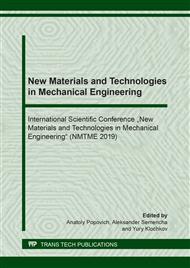[1]
Klinkov, V. Aseev, V., Semencha, A., Tsimerman, E. Temperature sensor based on upconversion luminescence of Er3+-doped fluoroaluminate glasses, Sensors and Actuators, A: Physical. 117 (2018) 157-162.
DOI: 10.1016/j.sna.2018.04.048
Google Scholar
[2]
Markov V.A., Semencha A.V at all. Adhesive As-S-Se-I immersion lenses for enhancing radiation characteristics of mid-IR LEDs operating in wide temperature range. Infrared Physics and Technology. Infrared Physics and Technology. 78 (2016) 167–172.
DOI: 10.1016/j.infrared.2016.07.020
Google Scholar
[3]
Kurushkin, M.V., Semencha, A.V., Zaitsev, D.A., Blinov, L.N. Utilization of the wastes of chalcogenide glass of the As-S-I system, Glass Physics and Chemistry. 40 (2014) 388-390.
DOI: 10.1134/s108765961403002x
Google Scholar
[4]
Semencha A.V., Kurushkin M.V., Markov V.A. Moisture resistance of the As-S-I glasses. Advanced Materials Research. 1061-1062 (2015) 987-990.
DOI: 10.4028/www.scientific.net/amr.1061-1062.987
Google Scholar
[5]
Lin F. C., Ho S. M. Chemical durability of arsenic-sulfur-iodine glasses. Jornal of the American ceramic society. (1963) 24.
DOI: 10.1111/j.1151-2916.1963.tb13765.x
Google Scholar
[6]
N. I. Krylov, L. N. Blinov Halogen-containing chalcogenide glasses: Synthesis and properties Glass Physics and Chemistry. 43 (2017) 326–329.
DOI: 10.1134/s1087659617040071
Google Scholar
[7]
L. N. Blinov Glass chemistry: Problems, perspectives, and application (A review). Glass Physics and Chemistry. 42 (2016) 429–439.
DOI: 10.1134/s1087659616050047
Google Scholar
[8]
Semencha, A.V. Kurushkin, M.V. Email Author, Markov, V.A., Shakhmin, A.L. Vitreous arsenic sulfide doped with bismuth bromide Technical Physics Letters. 41 (2015) 429-432.
DOI: 10.1134/s1063785015050119
Google Scholar
[9]
Kurushkin, M.V. Semencha, A.V., Blinov, L.N. Mikhailov, M.D. Chalcogenide glass of the As2S3-I-Br system Glass Physics and Chemistry. 40 (2014) 267-26.
DOI: 10.1134/s1087659614020114
Google Scholar
[10]
Molla A., Trafder A. Synthesis and characterization of low Tg As‐S‐I chalcohalide glass for processing of raw diamonds. The Glass Age. 2 (2017) 132-135.
DOI: 10.1111/ijag.12194
Google Scholar
[11]
Borisova Z.U. Glassy Semiconductors, Leningrad State University, (1981).
Google Scholar
[12]
Micla V.I., Micla V.V. Molecular structure of Se-rich amorphous films. Journal of optoelectronics and advanced materials. (2010) 1827-1839.
Google Scholar
[13]
Strbac G., Strbac D . Effect of arsenic atom substitute with antimony on crystallization processes and thermal stability of the (Sb, As)-S-I system Journal of Non-Crystalline Solids 358(8) (2012) 1146–1152.
DOI: 10.1016/j.jnoncrysol.2012.02.011
Google Scholar
[14]
Alekberova R.I. at all. Local structures and optical properties of As-Se-Te(S) chalcogenide glasses Physica B: Condensed Matter. 550(1) (2018) 367-375.
DOI: 10.1016/j.physb.2018.09.031
Google Scholar
[15]
Tverjanovich A. Structure of Se–Te glasses by Raman spectroscopy and DFT modeling 101 (2018) 5188-5197.
DOI: 10.1111/jace.15758
Google Scholar
[16]
Krautkramer, K., Ultrasonic Testing of Materials, Springer-Verlag, New York, (1969).
Google Scholar
[17]
S. R. Luki, D. M. Petrovi. et al. Formation of complex structural units and structure of As-S-Se-Te-I glasses. (2003) 1223-1229.
Google Scholar
[18]
Kurushkin M.V., Markov V.A., Semencha A.V., et al. Determination of AsSI-SbSI glasses short-range structure via Raman spectroscopy, XPS and XRD. Int J Appl Glass Sci. 9 (2018); 85-89.
DOI: 10.1111/ijag.12279
Google Scholar
[19]
Lovu M. S., Shutov S. D., Andriesh A. M. et al. Spectroscopic studies of bulk As2S3 glasses and amorphous films doped with Dy, Sm and Mn. Journal of Optoelectronics and Advanced Materials (2001) 443 – 454.
Google Scholar
[20]
Onari S., Sugino O. Far Infrared Optical Properties of Amorphous As-Se System. Jurnal of Applaed Physics (1982) 418-423.
DOI: 10.1143/jjap.21.418
Google Scholar


